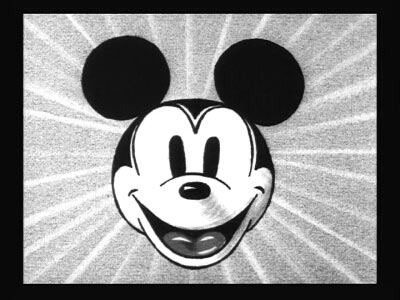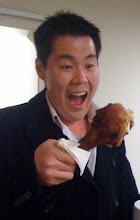I’ll be revisiting reoccurring themes in the science of cooking as this blog continues to grow in content and in ridiculous pictures. Water solubility, acid/base chemisty, time/temperature, and oxygen to name a few, but perhaps the most common will be the disassociation between fats and water. This picture here isn’t of an iconic mouse, but here to explain the structure of water.
[Source" thisdayindisneyhistory.homestead.com]
Water, also known as H2O, contains two smaller Hydrogen orbs that are positively charged and bind well to the larger, negative orb, oxygen. Remember…opposites attract…which poses the question in how Match.com works…In water, there are two positive hydrogen molecules compared to one single negative oxygen molecule. Despite lacking in numbers, the renegade oxygen’s charge overpowers that of the two hydrogren and water as a whole has a negative charge, or polarity. Because of this charge, water also tends to stick to one another and form pretty structures such as this:
[Source: practicalchemistry.org]
Fat, on the otherhand, is generally composed of a carbon backbone and hydrogen appendages, (include oxygen if you’re talking about unsaturated fats). As opposed to water that has a strong-negative and weak- positive component, the fat molecule as a whole generally has no-charge associated with it; it is neither positive nor negative. It’s like the apathetic voter…it just sits there and chill, while water likes to comingle and get into heated debates with its negatively charged brethren, or it’s positively charged rivals. However, it dares not associate with the neutral dude that sits around twiddling his thumbs. I’m only glossing over the charge/polarity discussion, but there are many other molecular interactions occurring that I won’t bore you with (today).
So what’s this have to deal with noodles? Other than the first time where I burnt pasta (yes, it’s possible), I’ve always had a problem with my spaghetti sticking to one another after removing it from its hot bubbly bath. Even Chef Boyardee would snicker at my pool of Prego and a brick of yellow noodles floating like a Valdez accident. Well, you remember how, a long time ago (in a blog far, far away) I mentioned how dissolved starch forms on the outside of cooked pasta? The chemistry of the noodle isn’t the reason why they cling onto one another, but rather, the residual water that adheres to the carbohydrate causes the noodles to stick. Water surrounds and engulfs the starch and clings all around the noodle, and water molecules further reach out to neighboring mickey mouses to form a stronger bond.
Now the cool thing about oil is that it interferes with the strong interaction of the H2O bonding. In non-nerd talk, it roosterblocks water. “Yah, take that water, think you can just poke your hydrogen balls all over the place?” The negative polarity of the water molecule doesn’t sit well next to the neutral fat molecules and Mr. fatty tells water to GTFO.
So if you’re cooking pasta, here are some techniques to ensure your noodle doesn’t stick: You can add a small amount of oil into your boiling pot of water prior to cooking the noodle. In addition, you can some oil or butter to the pasta after draining and stirring that immediately to interfere with the water. This works wonders especially in cream-based sauces such as an alfredo or if you’re frying up the noodle like in chow mein/fun.
Out of curiosity, which topics seems more appealing to you? “Cooking without Fire” or “Freezers that Burn"?




No comments:
Post a Comment